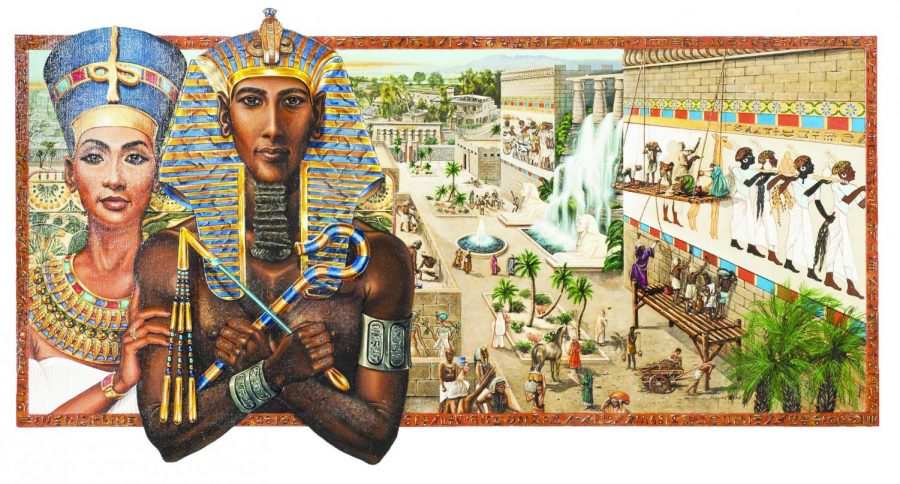Acknowledging Africa
Accumulated knowledge originating from classic African civilizations stolen by Europeans
Akhenaton Pharaoh of Egypt (1375-1358 B.C.), by Barbara Higgins Bond, places him with his wife Queen Nefertiti, in front of a city. Akhenaton and Nefertiti were the first monotheistic rulers in history. Their reign radicalized the Egyptian civilization’s view of life.
Dec 5, 2018
Impactful lessons surrounding ancient African artifacts focused on teaching students about diverse histories were shared to a packed lecture hall completely filled with a diverse group of attendees.
Manu Ampim, history, anthropology and geography department chairperson, shared his research findings in his “Southern Origins: Classical African Civilizations” presentation in GE-225 on Nov. 27.
To present a broader understanding of history and contributions from African civilizations is why he gave this presentation, Ampim said.
Ampim started the presentation by showing architectural achievements from ancient Egypt. He went through slides of Western monuments and architecture shedding light on the African influences that were present in each structure.
“Why would George Washington have an obelisk and a reflecting pool? He was a stonemason, an admirer of African culture,” Ampim said referring to the Washington Monument.
The world’s’ first stone obelisk can be linked back to the ancient civilizations of Tekhen as far back as 1500 B.C.E.
There were rarely pauses in the presentation as each slide inspired lessons from Ampim.
The lecture hall was focused intently on each word in the presentation.
College President Katrina Vanderwood said, “It’s great to see the whole room filled — to see the campus turn out for something so important.”
Ampim shared photos of the pyramids in ancient Kush and the Dahshur pyramids. These structures show an advanced understanding of arithmetic present in ancient cultures, he said.
He also showed photos of some of his time spent in isolated areas in Sudan.
They were places so tightly guarded he had to first pass a security clearance.
Pictures of the Mursi communities he had visited filled the screen.
Different civilizations have proudly passed down their own traditions. The Nuer tribe had distinct scars marked across their foreheads in patterns different from the Dinku and Shilluk.
Patterns were each made to represent their heritage and marked proudly.
Ampim also shared what real African warriors look like —men with cuts lined across their chests, ostrich feathers on their head and an assault rifle over their shoulder.
Photos mixing pieces of modern life and their traditions.
The cuts represented the number of lives the warrior had taken and the ostrich feather is a symbol of high status.
His research was conducted by observing these civilizations and histories “as a subject of their own experience rather than a focus of contempt.”
Field research done so far on these subjects had left more to be desired for Ampim.
Students in the audience were completely engaged while listening to the historic contributions from African civilizations.
“As an African-American, it’s very important to be enlightened about African civilization, to see your ancestors and what it means” undecided major Alexander Watley said.
Many ancient African contributions have been overshadowed by a trend of Western education failing to teach a full accurate history, Ampim said.
This concern fueled him as humanities classes were facing cuts last year.
The proposed cuts led to a rally from professors to defend a broader and more inclusive education.
Later, Ampim pointed out the Western created idea of the black pharaohs.
That many media outlets in the early 2000s had begun to instill the idea that before the 24th dynasty in ancient Egypt, there were no black rulers.
Major publications were misrepresenting history in a way that discredited the histories of African cultures, he said.
Academic beliefs were also misconstrued Ampim said.
The Greek philosopher Pythagoras, being the father of the Pythagorean theorem was a misinformed concept.
“The Greeks cannot possibly be given credit for an African contribution,” he said.
The same theorem was actually found in the Rhind mathematical papyrus from ancient Egypt, recorded more than 1,000 years before it was in Greek history.
Ampim said even generally known artifacts from ancient civilizations, such as hieroglyphs, hold importance.
The practice required precision nothing short of an art form and explained how integral harmony and proportion is to the final product.
Ancient Egyptian morals teacher Ptah Hotep wrote the world’s first book, Ampim said, titled “37 lessons on moral and ethical conduct.”
All of these advancements are contributions to the African identity, Ampim said.
As the presentation came to an end, Ampim showed images of many ancient artisans and academics.
He said, “I show them because they are often not as appreciated as their contributions.”




Augusta Kelly • Dec 21, 2018 at 8:12 am
Thank you professor, we’re so grateful for real information. We’ve been misinformed for years. I’m learning and growing . Thanks again for the work you’re doing, and the information you’re providing.
Augusta Kelly